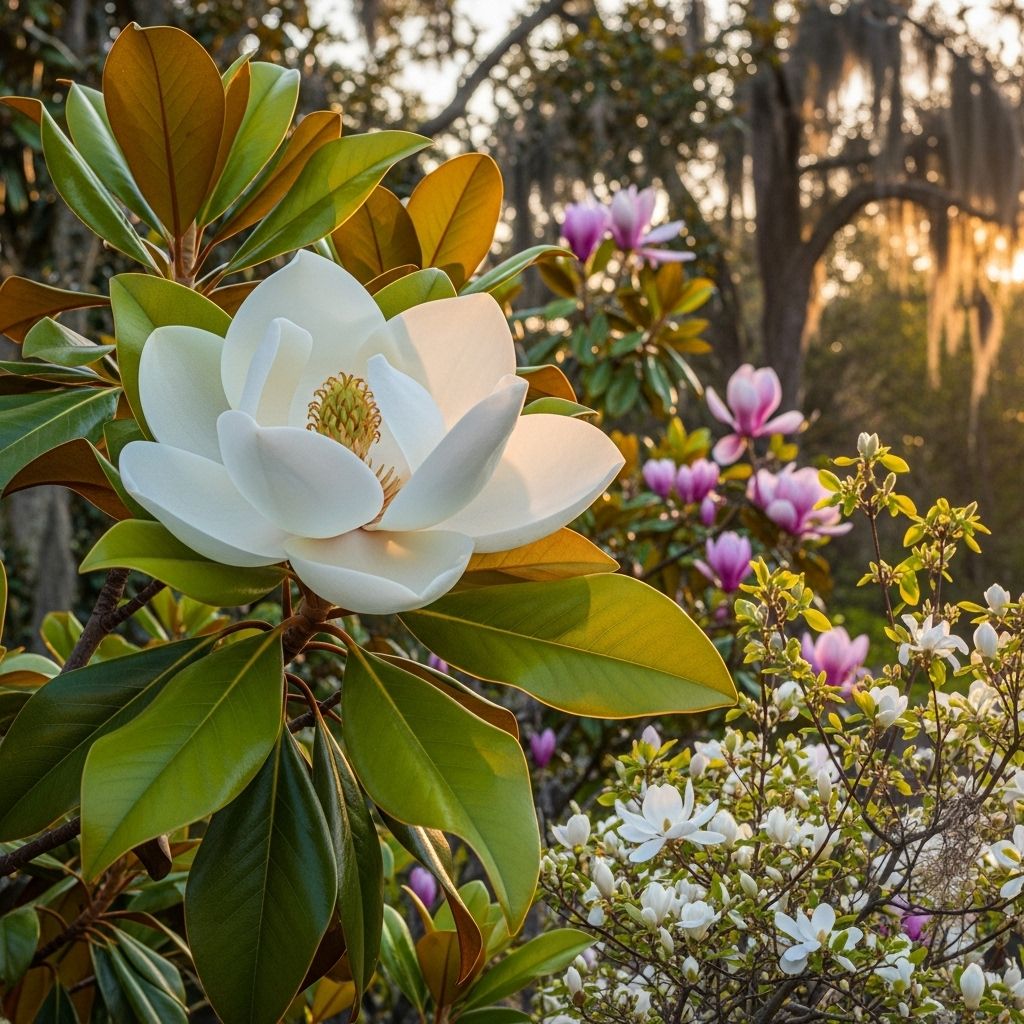13 Best Magnolia Trees for Florida Gardens: Growing Tips, Varieties & Care
Variety-specific planting guidance helps you achieve lush blooms that thrive in humid climates.

Image: HearthJunction Design Team
13 Types of Magnolia Trees for Florida Gardens
Florida’s unique climate—ranging from subtropical to tropical—makes it an excellent habitat for a wide range of plants. Among flowering trees, magnolias (genus Magnolia) stand out for their bold blossoms, glossy leaves, and adaptability. From the stately Southern Magnolia of North Florida to tropical varieties thriving in the southern tip, there is a magnolia suitable for every Floridian garden.
This guide explores the most popular and resilient magnolia varieties for Florida, covering key attributes, ideal zones, special care tips, and design inspiration to help you choose and grow the perfect magnolia for your landscape.
Understanding Florida’s Magnolia-Friendly Climate
Florida’s planting zones (8–11) include a wide variety of climatic regions. North Florida’s cooler winters allow hardy species to thrive, while the warmth and humidity of Central and South Florida are ideal for subtropical and tropical cultivars. Importantly, even with Florida’s notorious heat and humidity, most magnolia varieties perform well if matched to their preferred zone and site conditions.
Top Magnolia Varieties for Florida
| Common Name | Botanical Name | Bloom Color | Height x Width | Sun | Hardiness Zones | Best For |
|---|---|---|---|---|---|---|
| Southern Magnolia | Magnolia grandiflora | White | 60–90′ x 40′ | Full Sun to Part Shade | 7–10 | Specimen, shade |
| ‘Little Gem’ Magnolia | Magnolia grandiflora ‘Little Gem’ | White | 15–20′ x 7–10′ | Full Sun | 7–10 | Small yards, hedges |
| Sweetbay Magnolia | Magnolia virginiana | Creamy white | 10–60′ x 10–35′ | Full Sun to Part Shade | 5–10 | Wet sites, fragrance |
| Green Shadow | Magnolia virginiana ‘Green Shadow’ | White | 35′ x 18′ | Full Sun to Part Sun | 5–10 | South Florida, wet soils |
| Banana Shrub Magnolia | Magnolia figo | Yellow-green | 8–15′ x 6–10′ | Part Shade | 8–11 | Evergreen, fragrance |
| Teddy Bear Magnolia | Magnolia grandiflora ‘Southern Charm’ | White | 20–30′ x 10–12′ | Full Sun | 7–9 | Upright, compact sites |
| Star Magnolia | Magnolia stellata | White | 15–20′ x 10–15′ | Full Sun to Part Shade | 4–9 | Earliest blooms |
| Bracken’s Brown Beauty | Magnolia grandiflora ‘Bracken’s Brown Beauty’ | White | 30–50′ x 15–30′ | Full Sun | 5–9 | Compact evergreen |
| D.D. Blanchard Magnolia | Magnolia grandiflora ‘D.D. Blanchard’ | Creamy white | 40–50′ x 20–30′ | Full Sun | 7–10 | Tall, dense foliage |
| Saucer Magnolia | Magnolia × soulangeana | Pink, purple, white | 20–25′ x 20–25′ | Full Sun to Part Shade | 5–9 | Large flowers |
| Japanese Magnolia | Magnolia × soulangeana | Purple-pink | 20’ x 20’ | Full Sun to Part Shade | 5–9 | Showy blooms |
| Cucumber Tree Magnolia | Magnolia acuminata | Yellow-green | 40–70′ x 30–50′ | Full Sun | 4–8 | Shade, pollinators |
| Champaca Magnolia | Magnolia champaca | Orange-yellow | 30–50’ x 10–30’ | Full Sun | 10–11 | Tropical gardens |
Magnolia Trees: Characteristics and Growing Habits
Magnolia trees are prized for several features:
- Showy, fragrant flowers: Large, often white, pink, or purple blooms offer an unmistakable presence in the garden, sometimes spanning up to 12 inches.
- Glossy evergreen leaves: Especially in southern cultivars, the foliage is attractive year-round, providing a lush backdrop.
- Versatility: Ranging from towering shade trees to compact shrubs, magnolias serve as specimens, hedges, or privacy screens.
- Tolerance for various soils and climates: Most are adaptable to the wet summers and sandy or clay soils found across Florida.
Growth Rates
Magnolias can have slow-to-moderate growth rates. Compact varieties, like ‘Little Gem,’ grow more quickly, while the classic Southern Magnolia is noted for its stately, slow maturation—often taking decades to reach full size.
Planting and Caring for Magnolias in Florida
To make the most of these magnificent trees, follow these essential care tips:
Site Selection
- Space: Know the mature size of your chosen variety; magnolias do not respond well to severe pruning once established.
- Sunlight: Most magnolias thrive in full sun, though some tolerate partial shade, especially in southern Florida’s heat.
- Location: Avoid placing them near walkways or lawns if you want tidy spaces—magnolias shed leaves and seedpods each spring.
Soil and Watering
- Soil preference: Moist, well-drained, slightly acidic soil is ideal. Varieties like ‘Green Shadow’ are also tolerant of wet or clay-heavy soils.
- Mulching: Apply 3–4 inches of mulch, but avoid covering the base of the trunk or root ball.
- Watering: Water deeply when the tree is young, especially during dry spells or hot weather. Mature trees are relatively drought-tolerant but still benefit from occasional deep watering.
Planting Advice
- Timing: Container-grown trees can be planted year-round. For balled-and-burlapped trees, plant from August through October.
- How to plant: Dig a hole twice the width and almost as deep as the root ball. Plant with the root ball slightly above ground level. Backfill and water thoroughly.
- Transplant shock is common; expect some leaf drop during the first season after planting.
Best Magnolia Varieties For Each Florida Region
- North Florida (Zones 8–9): Southern Magnolia, ‘Bracken’s Brown Beauty,’ Star Magnolia, Japanese Magnolia, Cucumber Tree Magnolia
- Central Florida (Zones 9–10): ‘Little Gem’ Magnolia, Sweetbay Magnolia, Teddy Bear Magnolia
- South Florida (Zones 10–11): Green Shadow, Banana Shrub Magnolia, Champaca Magnolia
Popular Magnolia Cultivars and Their Features
Southern Magnolia (Magnolia grandiflora)
A classic southern icon, this large evergreen can reach up to 90 feet. Its creamy white, lemon-scented blossoms and dark green foliage make it a landscape favorite. It’s often planted for shade or as statement specimens.
‘Little Gem’
Perfect for smaller spaces, this compact variety blooms early and often, producing large, fragrant flowers and dense foliage. Ideal for patios, small lawns, and formal landscapes.
Sweetbay Magnolia (Magnolia virginiana)
An adaptable and semi-evergreen species native to wetlands, Sweetbay offers citrus-scented, ivory blossoms from spring to midsummer. Its tolerance of wet soils makes it excellent for low-lying or poorly drained sites.
‘Green Shadow’
This evergreen selection of Sweetbay is highly prized in South Florida. It tolerates humidity, clay, sandy, and even salt-affected coastal soils, making it perfect for both inland and coastal gardens.
Banana Shrub Magnolia (Magnolia figo)
This small evergreen shrub produces banana-scented yellow-green blooms, making it a charming choice for hedging or foundation plantings.
Teddy Bear Magnolia (Magnolia grandiflora ‘Southern Charm’)
With an upright, compact habit and rich evergreen foliage, Teddy Bear is excellent for creating privacy or as a tidy accent tree.
Star Magnolia (Magnolia stellata)
One of the earliest spring bloomers, Star Magnolia dazzles with abundant white blossoms and performs best in cooler North Florida gardens.
Bracken’s Brown Beauty
This cultivar offers dense, rust-colored foliage undersides and reliable flower production, making it favored for evergreen screening or specimen planting.
Champaca Magnolia (Magnolia champaca)
Native to Southeast Asia, this tropical magnolia bears orange-yellow, powerfully fragrant blooms all summer—suited exclusively to the warmest, frost-free parts of South Florida.
Magnolia Tree Uses in the Landscape
- Specimen Trees: Show off stunning flowers and foliage as centerpieces in gardens or lawns.
- Privacy Screens: Plant upright cultivars in a row to block unsightly views or establish garden boundaries.
- Foundation Plantings: Compact varieties are effective near buildings to soften lines and provide low-maintenance beauty.
- Wildlife Gardens: Sweetbay and other native species attract birds and pollinators.
- Espalier: With patience, some magnolias can be trained flat against fences or walls for dramatic effect.
Common Questions About Growing Magnolias in Florida
Q: What is the best magnolia tree for small yards?
A: ‘Little Gem’ Magnolia is compact, reaching just 15–20 feet, and produces large flowers, making it perfect for smaller landscapes.
Q: Will magnolias tolerate Florida’s humidity and hot summers?
A: Yes, most magnolia varieties recommended here are well adapted to Florida’s climate and humidity. Ensure adequate watering during hot spells, especially for young trees.
Q: Do magnolias need special soil?
A: Magnolias grow best in slightly acidic, moist, well-drained soil. Some selections tolerate heavier clay or sandy soils, but they do not thrive in alkaline or very salty positions. Conduct a soil test before planting and amend as needed.
Q: Is heavy leaf drop normal?
A: Some leaf and pod drop each spring is perfectly normal, especially after planting or during stressful weather changes. This helps the tree manage water loss and energy use.
Magnolia Planting and Maintenance Tips
- Mulch generously to preserve moisture and reduce weeds, but keep mulch a few inches from the trunk.
- Fertilize lightly in spring with a balanced, slow-release fertilizer formulated for acid-loving plants.
- Prune only to remove dead, damaged, or crossing branches. Magnolias generally dislike heavy pruning once established.
- Water extra during drought or heat waves, especially for younger or recently planted trees.
- Protect the root zone—avoid frequent foot traffic or mowing near the base, as surface roots are sensitive.
Frequently Asked Questions (FAQs)
Q: Can I grow magnolia trees in containers?
A: Dwarf and shrub-type magnolias, such as Star Magnolia and some compact hybrids, can do well in large containers with excellent drainage and regular care.
Q: When is the best time to plant magnolias in Florida?
A: Container-grown magnolias can be planted at any time. For balled-and-burlapped trees, late summer to early fall is recommended for best results.
Q: How far apart should magnolia trees be spaced?
A: Space large trees like Southern Magnolia 20–40 feet apart. Compact and shrub varieties may be spaced 8–12 feet for hedging or screening.
Q: Are magnolia trees messy?
A: Magnolia trees shed leaves, seed pods, and occasional twigs, so they may not be the best choice immediately adjacent to patios, pools, or manicured lawns.
Q: Do magnolias attract pests or diseases in Florida?
A: Magnolias are generally low-maintenance and not prone to major pests. Occasionally, scale insects, leaf spot, or sooty mold may occur but rarely threaten overall plant health.
Conclusion
Magnolia trees offer iconic beauty, fragrance, and versatility for Florida gardens. Whether you want to create a bold focal point or add a fragrant screen, there’s a suitable magnolia variety for every region and landscape style. With thoughtful site selection, proper soil preparation, and ongoing care, your magnolia will thrive and become a cherished part of your garden for generations.
References
Read full bio of medha deb












